|
The
|
||||||||||||||||||||||||||||||||||||||||||||||||||||||||||||||||||||
THE BURGENLAND BUNCH NEWS - No. 218 February 29, 2012, © 2012 by The Burgenland Bunch All rights reserved. Permission to copy excerpts granted if credit is provided. Editor: Thomas Steichen Our 16th Year. The Burgenland Bunch Newsletter is issued monthly online. It was founded by Gerald Berghold (who retired Summer 2008 and died in August 2008). |
||||||||||||||||||||||||||||||||||||||||||||||||||||||||||||||||||||
Current Status Of The BB: * Members: 2024 * Surname Entries: 6887 * Query Board Entries: 4890 * Staff Members: 17 |
||||||||||||||||||||||||||||||||||||||||||||||||||||||||||||||||||||
This newsletter concerns: 1) THE PRESIDENT'S CORNER 2) HANNERSDORF TRIP REPORT (by William J Best) 3) A VIENNA ORPHAN (by John Holler) 4) A VIDEO MAP OF THE HABSBURG EMPIRE 5) THE SEARCH FOR NUMBER 16 (by Amy Coffin) 6) EDUCATION IN BURGENLAND IN THE 1890'S 7) THE EUROPEAN REGIONAL DEVELOPMENT FUND IN BURGENLAND 8) FINDING A “LOST” COUSIN (by Frank Paukowits) 9) HISTORICAL BB NEWSLETTER ARTICLES: - TASTE OF THE BURGENLAND - KÜBISKERNÖL - NEWS FROM RIEDLINGSDORF 10) ETHNIC EVENTS (courtesy of Bob Strauch, Kay Weber & Margaret Kaiser) 11) BURGENLAND EMIGRANT OBITUARIES (courtesy of Bob Strauch) |
||||||||||||||||||||||||||||||||||||||||||||||||||||||||||||||||||||
1) THE PRESIDENT'S CORNER (by Tom Steichen)  Concerning
this newsletter, we offer a mix of articles beginning with William Best's Hannersdorf trip
report and John Holler's quest to answer his grandmother's life-long questions. Concerning
this newsletter, we offer a mix of articles beginning with William Best's Hannersdorf trip
report and John Holler's quest to answer his grandmother's life-long questions. We follow those with an interesting Video Map of the Habsburg Empire, a different take on a staff assistance effort and some information on 1890s Burgenland education. Like I have for a number of newsletters, I next offer another report on an EU Structural Fund in Burgenland, this time, the European Regional Development Fund (ERDF). Lastly, Frank Paukowits brings us up-to-date on the Burgenland DNA Project (and a little twist therein) before I close by providing our standard sections: Historical Newsletter Articles, and the Ethnic Events and Emigrant Obituaries sections. First, though, my little tidbits... interesting stuff but too short to be full articles...  Perhaps
you noticed (or not) that BB membership passed the 2000 mark in January. I must
confess that I, of all people, missed it when it occurred... but when I noticed it early in
this month, it caused me to be curious how our membership has increased over these past 15
years. As you can see from the chart at the right, it has been a nearly straight-line increase
from the original 12 correspondents who received the first newsletter to the 2,025 members at
the end of January of this year! Perhaps
you noticed (or not) that BB membership passed the 2000 mark in January. I must
confess that I, of all people, missed it when it occurred... but when I noticed it early in
this month, it caused me to be curious how our membership has increased over these past 15
years. As you can see from the chart at the right, it has been a nearly straight-line increase
from the original 12 correspondents who received the first newsletter to the 2,025 members at
the end of January of this year!Not surprisingly, the number of surnames we list and the number of entries on the query board parallel this behavior (at least, they do so since 2005, which is when we started tracking those numbers). Our surname count is now over 6,800 and there have been over 4,800 query entries on the board. All of this suggests that our membership has yet to plateau, meaning there are still quite a few more people out there with interest in Burgenland genealogy who have yet to find us. In the April 2008 edition of the newsletter, Gerry Berghold estimated that there were about 40 to 50 thousand Burgenland emigrants who came to North America. If we assume an average family size of 4 per emigrant family, that suggests that there are 10 to 12.5 thousand families who emigrated... meaning our current surname count is approaching about half of the estimated total... not bad for being at this for just 15 years! If we have a demographer among us, and you can give us a better approximation, I'd be interested in hearing from you. 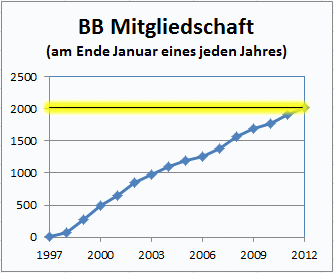 Vielleicht
habe Sie es bemerkt, oder auch nicht, dass der Mitgliederstand des Burgenland Bunchs
(BB) im Jänner die 2000er Marke erreichte und überschritt. Ich muss leider bekennen,
dass ausgerechnet ich, von allen Betroffenen, diesen wichtigen Anlass komplett versäumte.
Allerdings, als mir dann anfangs dieses Monats (März) mein Übersehen bewusst wurde, nahm ich
die Gelegenheit wahr, der Frage nach der Entwicklung des BB Mitgliederstandes über die letzten
15 Jahre nachzugehen. Wie Sie aus der rechten Figur ersehen können, wuchs die Zahl der
Mitglieder nahezu linear von den ursprünglich 12 Korrespondenten, die den ersten Newsletter
erhalten hatten, zu den 2.025 Mitgliedern von Ende Jänner dieses Jahres. Vielleicht
habe Sie es bemerkt, oder auch nicht, dass der Mitgliederstand des Burgenland Bunchs
(BB) im Jänner die 2000er Marke erreichte und überschritt. Ich muss leider bekennen,
dass ausgerechnet ich, von allen Betroffenen, diesen wichtigen Anlass komplett versäumte.
Allerdings, als mir dann anfangs dieses Monats (März) mein Übersehen bewusst wurde, nahm ich
die Gelegenheit wahr, der Frage nach der Entwicklung des BB Mitgliederstandes über die letzten
15 Jahre nachzugehen. Wie Sie aus der rechten Figur ersehen können, wuchs die Zahl der
Mitglieder nahezu linear von den ursprünglich 12 Korrespondenten, die den ersten Newsletter
erhalten hatten, zu den 2.025 Mitgliedern von Ende Jänner dieses Jahres.Es kommt kaum als Überraschung, dass die Anzahl der von uns gelisteten Nachnamen, sowie auch die Zahl der Postings auf unserem Frage-Board, eine parallele Entwicklung zeigen, zumindest seit dem Jahre 2005, als wir begannen, diese Zahlen zu verfolgen. Die Liste von Nachnamen zählt heute über 6.800 Einträge, während die Zahl der Anfragen und Postings auf unserem Burgenland-Board auf über 4.800 angewachsen ist. Diese Fakten legen nahe, dass unser Mitgliederstand noch kein Plateau erreicht hat, was in anderen Worten bedeutet, dass es noch eine erhebliche Anzahl von Personen mit Interesse für Burgenlandgenealogie geben muss, die uns noch zu finden haben. Im BB Newsletter vom April 2008 machte Gerry Berghold die Schätzung, dass ungefähr 40 bis 50 Tausend Burgenländer nach Nordamerika ausgewandert sind. Unter der Annahme einer durchschnittlichen Familiengrösse von vier Personen wären es somit 10 bis 12,5 Tausend Auswandererfamilien gewesen. Dies würde bedeuten, dass die laufende Zahl von Einträgen in unserer Liste von Nachnamen sich der Hälfte der geschätzten Gesamtzahl nähert ... kein schlechtes Resultat für bloss 15 Jahre. Falls es unter uns einen Demographen gibt, welcher eine bessere Approximation geben könnte, wäre ich interessiert, von ihr oder ihm zu hören. 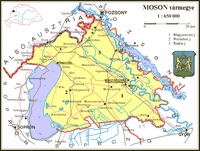 BB
Member, Gerry Mulligan recently shared electronic copies of two maps of Hungary. This
reminded me that I have quite a few maps of Hungary and/or the portion of pre-1921 West
Hungary that became Burgenland... and that there was no good reason for not having posted them
on the BB website. So, thanks to Gerry's stimulating gift, please find a new "Hungarian
Maps" BB webpage at
http://www.the-burgenland-bunch.org/Hungary/Hungary_Maps.html. Since then, Klaus has also
contributed some maps for this page. If you have some maps that you believe would be a
good addition, please consider sharing them with the BB. BB
Member, Gerry Mulligan recently shared electronic copies of two maps of Hungary. This
reminded me that I have quite a few maps of Hungary and/or the portion of pre-1921 West
Hungary that became Burgenland... and that there was no good reason for not having posted them
on the BB website. So, thanks to Gerry's stimulating gift, please find a new "Hungarian
Maps" BB webpage at
http://www.the-burgenland-bunch.org/Hungary/Hungary_Maps.html. Since then, Klaus has also
contributed some maps for this page. If you have some maps that you believe would be a
good addition, please consider sharing them with the BB.Margaret Kaiser reminded me that digital images of the Hungarian Civil Registration records are available on https://www.familysearch.org/ (go there then roll down toward the bottom of the page and click Europe, then click Hungary, then select this collection). I've known the images have been available for a while but sometimes it takes a reminder for me to remember to post such things! Anyway, below is the list of all Hungarian and Austrian collections currently available. As you can see below, the Civil Registration collection was last updated in December of last year; however, much of it has been out there nearly a year. Do note that this collection uses the old Hungarian name for villages now in Austria... if you know only the current Austrian name, you can use our BB Villages pages to find the Hungarian name. Collections that show a record count below have searchable indexes; those that say "Browse Images" only have the images... you must page through them like microfilm.
|
||||||||||||||||||||||||||||||||||||||||||||||||||||||||||||||||||||
2) HANNERSDORF TRIP REPORT (by William J Best) Editor: In the November 2011 issue (#215, article 3, Old to New House Numbers), I wrote about William Best's planned trip to Burgenland. He had inquired what the new address would be for an old Hannersdorf house number (it had not changed). Bill, from Jackson Hole, Wyoming, kindly shared his trip report to his extended family. Bill writes: In late December, we drove from Vienna (where we were visiting our daughter) to Hannersdorf to explore the Horvath family hometown, the birthplace of our grandfather. The drive was a very easy 2 hours (mostly on the A2), aided by a Garmin GPS, which meant we were never lost. 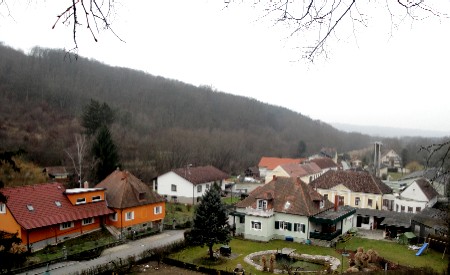 What
we found is summarized below. What
we found is summarized below.General: Hannersdorf is a town of about 400 population located in the rural wine growing region of Burgenland, Austria. This area was part of Austrian-Hungarian Empire until 1919. The region changed hands many times over the centuries, and thus the region is a real melting pot of peoples with Austrian, Hungarian, German and Croat heritage. I am told that the name Horvath is actually the Hungarian word for Croatian, which many immigrants to Hungary assumed when they came. Thus, it is a very common name in the region, found on many gravestones in the cemeteries. The Church and Baptismal Records: We found the baptismal record for Josef Horvath, our grandfather, at the Hannersdorf church. Born in 1887, he was baptized on the same day. This was common practice at the time, as there were many others with similar patterns. His parents were Andras and Maria Horvath (née Muellner). Their home is listed as House 52 in Hannersdorf, which we later found. It is noted that he departed for Chicago in 1913, which is consistent with our family 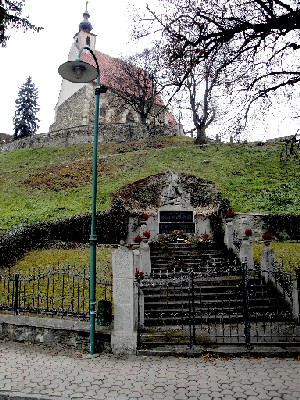 information. Andras is listed as "foldmives" which means an individual working in agriculture,
and Maria is listed as "Katholic." This is an interesting combination of identifiers,
occupation and religion.
information. Andras is listed as "foldmives" which means an individual working in agriculture,
and Maria is listed as "Katholic." This is an interesting combination of identifiers,
occupation and religion.The Hannersdorf church is located at the top of a steep hill overlooking the town. We had an opportunity to visit with the church secretary, who provided us with excellent information from the log of baptisms. She had found the baptism record of Josef Horvath. The baptismal record book of the church was amazing, essentially recording every baptism in the church back to the early 1800s. We were able to make copies with diocesan permission. We were not able to find the baptism records for either Andras Horvath or Maria Muellner, although time was short. Perhaps with more time, we could have found them. The exterior of the church was in somewhat rough condition, but the interior was in excellent shape. Services are still held every Sunday. War Memorial: Joseph Horvath, our grandfather, was part of a group from the Chicago area that helped fund the building of a war memorial in Hannersdorf in the mid to late 1920s. That war memorial is still standing, and has been expanded to include the deceased of World War II. It is located just below the Church on the main road at the roundabout. House 52: We found house 52 after about 45 minutes of cruising around the town, and went to the town hall to determine more. The house is now empty, and was sold to the township by the son of the last owner. We have a copy of the house ownership record. However, House 155 is now owned by Horvaths. Note that houses are numbered by the order in which they were built, which is fairly common is smaller rural towns in the area (similar situation in some areas of Tokyo). They just have not changed to the modern system. We learned that house 52 has had many owners since the Horvaths sold it many years ago. Horvaths: Horvaths are living in house 155, and were very welcoming to us. There is a major language barrier, as they speak only German, and we do not. However, we did gather the following information. Joseph Horvath (our grandfather) was his uncle. Joseph had one brother only, named Franz, who was about 12 years younger than Josef. Franz was about 14 when Josef left for the USA. Why Josef left we do not know, however, there was a large amount of emigration from this period through the 1930s. The son makes wine as a hobby, and we were given a bottle of Riesling with the name Horvath as the vintner. We will probably visit again, but will be better prepared with a German translator when we go. Hannersdorf Environs: Hannersdorf is clearly a rural agricultural town. Farm fields run right up to the houses in the town. We sensed that there are several newer structures that have been converted to summer homes or retreats for folks from the city. Visiting the cemetery, we found only 3 Horvath family markers, but none with familiar first names. It appears that families are buried in the same plot, with only the most recent names listed. No other names in the family are buried in the Hannersdorf cemetery. 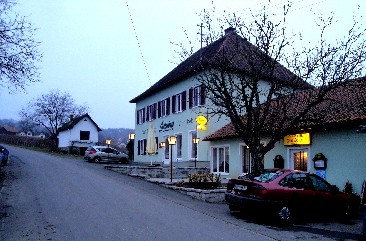 Gastoff
Hotel zum Weinberg: We stayed overnight at a hotel in Kohfidisch named the Weinberg
in the Csaterberg region. This guest house is literally situated among working vineyards,
which are planted to within 50 yards of the building. It has 14 rooms. However, the owner,
Martin, is very hospitable and speaks English well. His wife is an excellent cook (try the
pork medallions or skewer chicken). They have a wine tasting room and a separate room devoted
to amateur geologists in the region, who have a fine display of local rocks. Apparently, this
guest house is very crowded in the summer months. We would strongly recommend staying here, as
it is very comfortable and welcoming. Gastoff
Hotel zum Weinberg: We stayed overnight at a hotel in Kohfidisch named the Weinberg
in the Csaterberg region. This guest house is literally situated among working vineyards,
which are planted to within 50 yards of the building. It has 14 rooms. However, the owner,
Martin, is very hospitable and speaks English well. His wife is an excellent cook (try the
pork medallions or skewer chicken). They have a wine tasting room and a separate room devoted
to amateur geologists in the region, who have a fine display of local rocks. Apparently, this
guest house is very crowded in the summer months. We would strongly recommend staying here, as
it is very comfortable and welcoming.Badersdorf: We also visited Badersdorf, where the my grandmother’s side of the family calls home, about 5 km from Hannersdorf. The church, built in 1852, was closed, as was most of the town. The excellent bakery, Aloisia's, was also closed over the holidays, but there were people inside cleaning. We were able to buy boxes of cookies. We also visited the cemetery, and found many grave markers with family names. |
||||||||||||||||||||||||||||||||||||||||||||||||||||||||||||||||||||
3) A VIENNA ORPHAN (by John Holler) In his last illness, my father called to me. He said that he dreamed of his mother and she was crying because she didn’t know whom she was or why she was given away. He wept for her remembered pain. So now, years later, I am searching for those answers. My grandmother was born Louise Khaupt on September 17, 1888 in Vienna, Austria. She was sent as a foster child to live with Peter and Erzebet Tamedle in Burgenland. Who were her birth parents? Why was she sent to grow up in Western Hungary? These were questions that haunted her all her life. Her daughter, Helen, told me she always hated filling out forms because she didn’t know what name to use. Who was Louise Khaupt? Peter and Erzebet Tamedle were a young Burgenland farm family with small children of their own to raise. They decided to foster Louise. Perhaps they needed the money the government offered for taking in these children. I do not know how old she was when she came to Burgenland. Louise had at least 5 foster siblings. She was cared for and loved by her brothers and sisters but never felt that she belonged in Burgenland. “A Vienna Bastard, that’s what I was called,” she said. The pain of those words was still with her half a century later. She grew up in a small community, Geresdorf, that valued strong family ties but she was forever an outsider with no family of her own. The Vienna foster children were supposed to be returned to Vienna after 6 to 10 years. If Louise was ever given that choice, it was never mentioned in our family. Louise wasn’t sent to school with her brothers and sisters but had to stay on the farm and help with the chores. Although school was mandatory at that time, there were fees involved. Perhaps the family or community had no money for her fees. Perhaps it was felt Vienna orphans weren’t worth the cost of educating. She knew that, without an education, her future was bleak. The stigma attached to being a Vienna orphan ruled out marriage. “Oh, no one would have married me, not if I stayed there,” she would whisper and shake her head. Louisa’s elder foster sister, Terez, immigrated to America and married a man named Beidl. After Terez was settled in Troy, New York, she sent money for her younger sister Maria to come to America. A whole new life opened for Louise because she was to accompany the 16-year-old Maria to America. They traveled to Antwerp and boarded the “Zeeland” bound for Ellis Island in the spring of 1909. In the fall of 1909, Frank Holler left Fürstenfeld, Austria, for Ellis Island. Eventually he made his way to Troy, NY, where he met and married Louise. They moved to New York City. Louise was pregnant with her first child, so Maria went to New York with Louise and Frank. One day Maria went to market and never returned. Though the family searched everywhere, no one ever heard from Maria again. A young girl lost to the streets of New York. 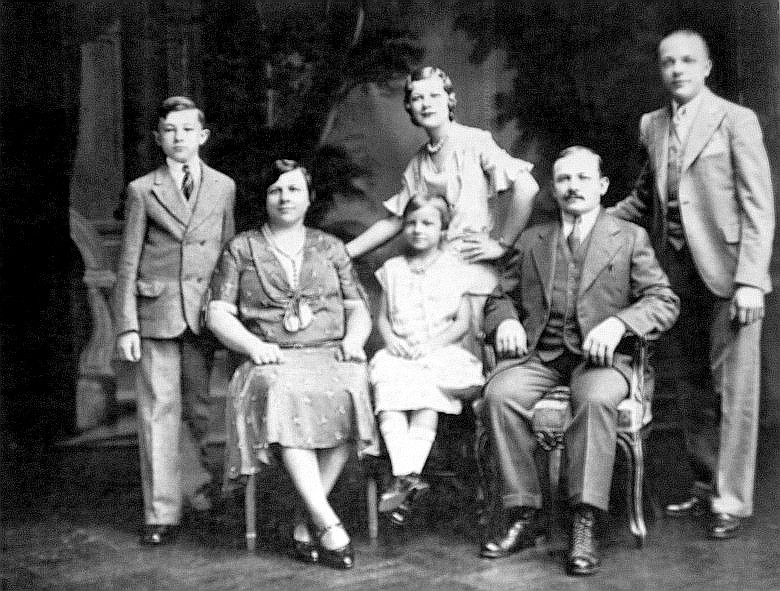 The Holler family c.1930; Frank and Louise Holler seated. Frank did not melt in the melting pot of New York. He was German. Only German was spoken in his house. He read German newspapers, listened to the German radio station and worked in a German brewery. When the children started school, they spoke only German. It was up to Louise to learn to speak, read and write English. She said that she had to teach herself these things because she needed to help her children with their schoolwork. English was spoken in the kitchen; elsewhere in the house, German was spoken. Ironically, as Louise reached a great age (she lived to be 94 years old), her mind traveled back to her days in Burgenland. She wanted to know why and how and would not accept pacifying clichés such as “your mother probably thought she was doing the right thing,” or “we’re all happy the way it turned out.” She wanted answers... but there were no answers for a Vienna orphan. Now, over a hundred years after Louise was born, I am searching for those answers... in her honor. 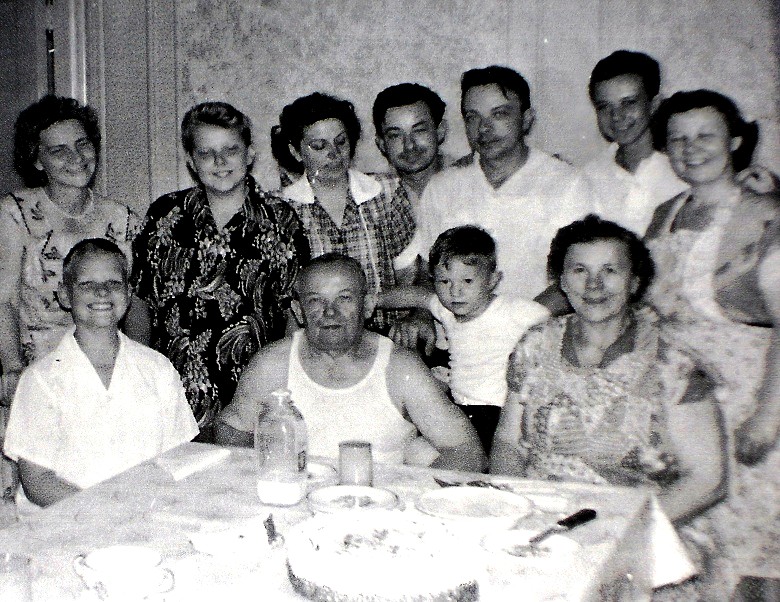 The Holler family 1954; I am the boy between my grandparents. |
||||||||||||||||||||||||||||||||||||||||||||||||||||||||||||||||||||
4) A VIDEO MAP OF THE HABSBURG EMPIRE Have you ever been confused about what parts of Europe (besides Burgenland) were parts of the Habsburg Empire? Well, in May 2011, Paul Rietvoorn of the Netherlands uploaded a YouTube video map showing all the known changes to the Habsburg Empire. The video, which runs nearly eight minutes, is a time-lapse series of overlaid maps and text showing each change to the Empire since its start in ~1276 until its demise in 1918. If you watch the whole thing, you'll know why you could not track the Empire's full extent. 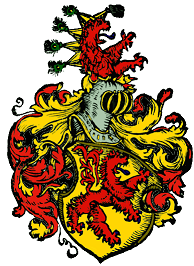 As
you likely know, Austria was ruled by the Habsburg dynasty; therefore, historical Austria is
also known as the Habsburg Empire or the Habsburg Monarchy. Wikipedia tells us that the House
of Habsburg "takes its name from Habsburg Castle, a fortress built around 1020–1030 in
present day Switzerland by Count Radbot of Klettgau, who chose to name his fortress Habsburg.
His grandson, Otto II, was the first to take the fortress name as his own, adding "von
Habsburg" to his title. The House of Habsburg gathered dynastic momentum through the 11th,
12th and 13th centuries. By 1276, Count Radbot's seventh generation descendant, Rudolph of
Habsburg, had moved the family's power base from Habsburg Castle to the Archduchy of Austria.
Rudolph had become King of Germany/Holy Roman Emperor in 1273, but the dynasty of the House of
Habsburg was truly entrenched in 1276 when Rudolph became sovereign ruler of Austria, which
the Habsburgs ruled for the next six centuries." As
you likely know, Austria was ruled by the Habsburg dynasty; therefore, historical Austria is
also known as the Habsburg Empire or the Habsburg Monarchy. Wikipedia tells us that the House
of Habsburg "takes its name from Habsburg Castle, a fortress built around 1020–1030 in
present day Switzerland by Count Radbot of Klettgau, who chose to name his fortress Habsburg.
His grandson, Otto II, was the first to take the fortress name as his own, adding "von
Habsburg" to his title. The House of Habsburg gathered dynastic momentum through the 11th,
12th and 13th centuries. By 1276, Count Radbot's seventh generation descendant, Rudolph of
Habsburg, had moved the family's power base from Habsburg Castle to the Archduchy of Austria.
Rudolph had become King of Germany/Holy Roman Emperor in 1273, but the dynasty of the House of
Habsburg was truly entrenched in 1276 when Rudolph became sovereign ruler of Austria, which
the Habsburgs ruled for the next six centuries."Austria became a major power in 1477 when the Habsburgs inherited much of what is now the Netherlands, Belgium and Luxembourg. Soon afterwards they inherited many more lands by their marriage policies. It was not until the end of World War I that nationalistic leanings in Europe finally dissolved the old Empire and divided it into many small states. Nonetheless, the video continues, showing all subsequent changes to Austria from 1918 to the current day. If you watch closely, you will see Burgenland added to Austria followed quickly by the loss of part of it due to the Sopron plebiscite. I think you will find it educational and well worth eight minutes of your life. If nothing else, you'll get to enjoy the 1866 music of Johann Strauss, as An der schönen blauen Donau (aka, The Blue Danube) is the background accompaniment. (I recommend that you click the little icon in the far lower right to see the video full screen.) |
||||||||||||||||||||||||||||||||||||||||||||||||||||||||||||||||||||
5) THE SEARCH FOR NUMBER 16 (by Amy Coffin) Ed Note: I often provide write-ups of Staff assistance provided to new BB members... however, this one is a little different. It was last April 8th when new member Amy Coffin, from Houston, TX, joined and, although I was copied on the assistance the staff provided, I just had too many good "member assistance" choices in the following months to write about this one for the newsletter. However, these many months later, while surfing the net to see what is being written about Burgenland genealogy, I came across Amy's blog, The We Tree Genealogy Blog, and a three-part article ("The Search for Number 16") where Amy writes about our help. Amy's blog home page is http://wetree.blogspot.com. The specific article starts at http://wetree.blogspot.com/2011/04/search-for-number-16-part-1.html, however, Amy has given me permission to quote it in its entirety, so you can read it below. By the way, I do love Amy's subtitle to her blog: "If family history is boring, then you're doing it wrong." I might add a corollary: if family history is unrewarding, then you are also doing it wrong. To the BB staff: read this story! It's your reward for your efforts on Amy's behalf! Thank you. The Search for Number 16 (by Amy Coffin) Thursday, April 28, 2011 The Search for Number 16, part 1  In
all of my family history research, there has always been a brick wall that frustrated me. I
did not know the name of my maternal grandmother's grandmother. That means that on a standard
five-generation family tree chart with me at the center and places for the names of my 16
great-great grandparents, there was always a blank at the bottom of the chart where a name
should be. In
all of my family history research, there has always been a brick wall that frustrated me. I
did not know the name of my maternal grandmother's grandmother. That means that on a standard
five-generation family tree chart with me at the center and places for the names of my 16
great-great grandparents, there was always a blank at the bottom of the chart where a name
should be.Now there are a lot of wonderful charts and artworks available where genealogists can create five-generation family trees. I've been frustrated for years that I couldn't take advantage of those items (especially the handcrafted ones) because I did not know the name of Number 16. I didn't want to spend all that money only to have a blank space at the bottom. Back in December, with the encouragement of a friend, I committed to finding that 16th great-great grandparent. I had a daughter's maiden name as well as a possible Austrian village hometown. What I didn't have was any experience searching this area of the world or any idea how to proceed with this task. 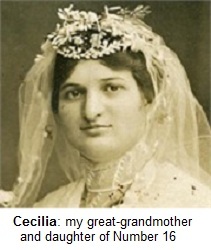 The
first effort I made was to list everything I knew about my Number 16's daughter, Cecilia Yost,
in a blog post. I didn't get any immediate response, but at least the details were out there. The
first effort I made was to list everything I knew about my Number 16's daughter, Cecilia Yost,
in a blog post. I didn't get any immediate response, but at least the details were out there.I did receive an email in regard to a post I made on a message board. The person said he/she had lots of information on the village of Inzenhof and the Jost family name. Great, right? Well I couldn't get any questions answered. I don't know if it was a language barrier or what but this lead didn't pan out. Admittedly, it was the resolution I made (as well as some good-natured teasing from friends) that got the ball rolling. I found this neat website called the Burgenland Bunch, which detailed genealogy information in the area where Cecelia was supposedly born. I joined up for free, gave out all the information I had and hit send. That simple effort opened a door... Thursday, April 28, 2011 The Search for Number 16, part 2 The simple effort of joining the Burgenland Bunch led to an almost immediate welcome email from one of the members. I replied back and quickly explained why I was there and what I hoped to find. A cordial email exchange ensued where I laid out my sob story of how I was looking for Cecilia's mom. I knew Cecilia had immigrated to the U.S. and landed in Pennsylvania. However, all my attempts at research in that state had led nowhere so I was attempting to search in Austria instead. Fast forward a few more emails and another door opened. In one reply, I was given the names of Cecelia's parents and grandparents. Bam! Just like that. My new Burgenland Bunch friend even provided the FHL microfilm numbers where she found the information. Well, you know me...even though I had the names, I needed to see them in order for this quest to be complete. So I placed my order for films and waited. Wednesday night, I received the phone call that said my films were in town. Naturally, I cleared the calendar on Thursday afternoon and moseyed on over to the family history center. Given the area and history of the era, these records were in Hungarian. Still, I had Cecilia's birth date so how hard would it be to find her record and the name of my Number 16? Turns out it was quite easy:  May I introduce you to Cecilia Kurta of Borosgodor, my Number 16 and great-great grandmother. Also in this set of records was confirmation of a marriage between Cecilia Kurta and Janos Joszt AND the names of their parents. Just like that, this line went from my most troublesome to my most advanced in Europe. Whew! But now that I have this information, what do I do with it? Well it turns out that my grandmother never knew the names of any of her grandparents. It also turns out that her birthday is Friday. Why not tell her about my discovery then? That's exactly what I intend to do. Sunday, May 1, 2011 The Search for Number 16, part 3 I called my grandma to wish her happy birthday on Friday. We first talked about her upcoming DNA test. I explained why I wanted her to do it and what I hope to get from it. The truth is that I don't know what will happen, if anything. She said something about being "the only one left." I explained that there were cousins everywhere. There's a possibility of a connection through DNA databases, or not, but she's definitely not the last. After the DNA lesson, I told my grandmother that I found her mother's birth record. My grandmother never knew her mother (death from TB when grandma was 3), so she's learning about her family as I find information. My grandmother's mom was born on the border of Austria and Hungary. This Hungarian influence is news to my grandma. I then told her the names of her mom's parents...her grandparents. I spelled out the names and she wrote them down. I can't imagine hearing my grandparents' names for the first time on my 83rd birthday, but that was the reality for my grandmother. "I wish I had known this sooner," she said. At least she knows now. And there's so much more to learn. The next step for me is to scour the microfilms that contain the birth and marriage information for my Number 16's Austrian village. The records span 1800-1895. I will start with 1895 and move backwards, looking for familiar names that connect to my family. Everything is in Hungarian, so this will take time. I know there are siblings out there, and I know I can move back several more generations in the family tree. My grandmother knows her grandparents. Now its time to discover some aunts and uncles. Perhaps this can be a goal for 2012. For now, however, I will be happy knowing my Number 16. One 2011 goal down, two more to go. |
||||||||||||||||||||||||||||||||||||||||||||||||||||||||||||||||||||
6) EDUCATION IN BURGENLAND IN THE 1890'S John Holler, of Jacksonville, FL, a recent new member (and the author of Article 3 above), asked Klaus Gerger about schooling in Burgenland in the 1890s. This is a topic that I suspect is of interest to other BB members so I present the responses below... John writes: Klaus, I was wondering if you know anything about schools in the 1890's in Burgenland. Were they free? Religious? How many years did most children attend? My grandmother's foster sisters and brothers attended school but she did not. Regards, John Klaus replies (and copied me): Hi John, an article in an old BB newsletter gives a little insight, but not exactly answers your questions: http://www.the-burgenland-bunch.org/Newsletter/NL/Newsletter%20053.htm. And here I found a little history of Gerersdorf in our archives: http://www.the-burgenland-bunch.org/V_Histories/Gerersdorf.htm. Most likely the school belonged to the r.c. parish, but had its own teacher. In Austria, mandatory primary education was introduced by Empress Maria Theresa in 1774. It was 6 years at that time. Best regards, Klaus Ed. Note: The first link provided above by Klaus refers to the following article from Newsletter 53 (March 15, 1999) The second link, the village history for Geresdorf, only has a very little bit about education so I'll not reprint it): EARLY SOUTH BURGENLAND SCHOOL PROBLEMS (Fritz Königshofer) Ed. (Gerry Berghold) Note: Following the reforms engendered by the Revolution of 1848, Austrian and Hungarian school teachers had the daunting job of providing a basic education which would eventually bring a mostly uneducated peasantry into the modern era. Today's excellent Burgenland school system is indicative of their success. The opportunity to achieve an education through the doctoral degree with government support, available in Austria today, is not matched by many countries. It would have  been
unthinkable in our ancestors' time. Post 1848 school teachers had their work cut out for them.
Large classes and poor facilities were just two of their problems. Not only did they
personally have to cope with German, Latin and Hungarian (Croatian in some cases), they had
insure that their students knew enough German and Hungarian to cope with normal bilingual
relationships. In addition, students who had the opportunity and ability to advance to
positions within the government, had to be fluent in Hungarian and often Latin as well. We
have already printed one article in which my 2g-grandfather, Mihaly Mühl, teacher in
Urbersdorf coerced the authorities to rebuild his school. Fritz Königshofer has now found
further examples of the educational struggle. been
unthinkable in our ancestors' time. Post 1848 school teachers had their work cut out for them.
Large classes and poor facilities were just two of their problems. Not only did they
personally have to cope with German, Latin and Hungarian (Croatian in some cases), they had
insure that their students knew enough German and Hungarian to cope with normal bilingual
relationships. In addition, students who had the opportunity and ability to advance to
positions within the government, had to be fluent in Hungarian and often Latin as well. We
have already printed one article in which my 2g-grandfather, Mihaly Mühl, teacher in
Urbersdorf coerced the authorities to rebuild his school. Fritz Königshofer has now found
further examples of the educational struggle.Fritz writes: When recently visiting Budapest, I managed to continue reading issues of Der Volksfreund. In 1889, I hit upon a huge controversy about the circumstances of the teacher job in Felsö-Rönök. Over several issues of Der Volksfreund, letters were written by the various parties. I believe the core issue was the discontent of the teacher at the time, Andreas Schlamadinger, about his pay conditions, specifically his inability to collect the full agreed remuneration from the families in the village and of two neighboring villages that sent children to the school in Oberradling. The controversy in the newspaper started in late April 1889, with an article about the general misery of the teaching conditions, an article that, for insiders, must have clearly alluded to the specific situation in Oberradling. This was followed by a letter to the editor. Then, in the issue of May 11, 1889, the R-C pastor of Oberradling, Nikolaus Herczeg, published a statement about the session of the village's school council, to which the village judge, Franz Artinger, added a further letter. I believe both opposed the earlier story written by teacher Schlamadinger who, they stated, was not even capable of writing correct letters in German and thus had been helped. The controversy continued in the issue of June 1, 1889 with a letter from Andreas Schlamadinger, who distanced himself from the original article that had stirred up the controversy while defending himself against the charge of lack of German language knowledge. A correspondent with the signature "Veritas" (truth) added a further article on the matter. (I believe that "Veritas" was the pseudonym used by a teacher in the Güssing/Strem area.) At that point, the debate fizzled out. Schlamadinger must have left the position soon afterwards since the teacher position of Oberradling was advertised as vacant in the spring of 1890. It appears it could not be filled for some time despite the nominally decent salary of 431 florins per year. [Ed note: In 1892, a "paper" florin (also known as a gulden or forint) was valued based on the silver florin at $0.32 to the florin. A kreutzer was 1/100th of a florin. Thus a yearly salary of 431 florins per year was equivalent to $138/year.] Perhaps teachers knew about the inability of actually collecting this remuneration. The post was readvertised in July 1890, and again in September 1890, when the offered remuneration was increased to 497 florins and 40 kreutzer [$159]. I am not sure whether the position was filled but, in January 1893, it was once again advertised, this time with a remuneration of only 384 florins and 10 kreutzer [$123], but with "decent living quarters" added. At that time, my great-grandfather Alois Koller won the competitive selection and became the teacher of Oberradling. Perhaps some of the other conditions had also been changed (such as the obligation to teach children from other villages). The time was already additionally impacted by the new and very serious problem of the condition of the old church, and the need to build a new one. When the old church was closed by the authorities due to its dangerous state, mass services and church administration were moved into the school house, once again making life intolerable for the teachers and their families. Frustrated, Alois Koller resigned his post in Oberradling in mid 1899. The next teacher successfully protested the conditions. In the early 20th century not only was a new church built (consecrated in June 1905), but also a new schoolhouse (in September 1909). I then replied: Hi John (and Klaus), I just got around to looking at this question of education. Below is a passage quoted from “The International Cyclopedia: a compendium of human knowledge” (1899, Edited by HT Peck, SH Peabody & CF Richardson). From this, I would say that elementary schooling (ages 6-14) was free, religious-based and required.
“The Encyclopedia of Social Reform” (1897, WDP Bliss, editor) indicates that Hungary
spent the equivalent of $0.42 per year per capita for elementary education in 1890 (and that
12.6% of the population was enrolled in elementary schools that year) while Austria spent
($0.22, Federal only) and had 13.1% enrolled. Combined, they had 5.3 million elementary
students in 1890… the text quoted above shows 8.8 million students in 1894, so there must have
been a push for greater compliance in the 1890s (or more children of the appropriate age). |
||||||||||||||||||||||||||||||||||||||||||||||||||||||||||||||||||||
7) THE EUROPEAN REGIONAL DEVELOPMENT FUND IN BURGENLAND In the November 2011 issue, I wrote about the ESF (European Social Fund) and followed that last month with an article about a successful project undertaken in the previous ESF funding cycle: the establishment of a regional funding agency called WiBAG. This month, I'm reporting on another EU Structural Fund administered under the umbrella of the Ziel-1 program: the European Regional Development Fund (ERDF) [in German: Europäischer Fonds für Regionale Entwicklung (EFRE)], which promotes economic and social cohesion in the European Union. This fund is used to eliminate the imbalances between regions or social groups. Like the ESF funding, the 2007-2013 cycle of ERDF funding for Burgenland is considered to be a "convergence phasing-out" objective, meaning one where support is reduced this cycle because the "need" category changed when the EU expanded from 15 to 25 members. Nonetheless, the total 2007-2013 ERDF budget for the Burgenland program is around €167 million (~230 million in US$) and the EU portion is €125 million (~172 million in US$). Burgenland is receiving approximately 8.6% of the total EU money invested in Austria under the ERDF in 2007-2013. Compared to Burgenland's current ESF funding (€69.5 million), total ERDF funding is ~2.4 times larger. The overall objective of Burgenland's ERDF program is to "develop further and broader the transition of Burgenland to a knowledge based economy and society through enhancements of competitive structures, promotion of attractive regions and guarantee of environmental sustainability." This is expected to contribute to the wealth and an increase in the quality of life for all inhabitants of the Burgenland and to reduce its regional disparity compared to other areas in Austria and Europe. According to the European Community's regional policy report for Burgenland, Operational Programme 'Burgenland' (the source for some of the material for this article), Burgenland's GDP (gross domestic product) per capita is only 89.8% of the EU average, therefore Burgenland's primary goal should be increasing the quality of life of its inhabitants. However, recognizing the challenges of the "globalising world" and the significant changes in the EU internal market after the 2004 eastern enlargement of the Union, it also states that Burgenland, as a former EU external border region, "needs to aim its support to continuous transition towards knowledge based economy and strengthening of its competitive structures through active participation on wider markets." The expected impact of the ERDF investment in Burgenland is "the creation of 577 new jobs, out of which 50 in the Research & Development sector, trigger a total investment of EUR 432 million (almost four times the Community assistance), install additional renewable energy capacity of 8.5 MW and decrease the greenhouse gases emissions by 95,000 tonnes/year." Like the ESF, Burgenland's ERDF program is structured into "priority axes": Priority axis 1, Competitiveness and Innovative Regional Economy Structures, is "reflected in the advancement of already commenced structural changes in particular in accordance with the Lisbon strategy objectives (see Lisbon Strategy). This is to be pursued through support of Research & Development, enhancement of networking, clusters and creation of competence centres, innovation and access to new markets." Priority axis 2, Infrastructure and Sustainable Regional Development, "aims at improvement of quality of lives for Burgenland inhabitants, reflects also the Gothenburg's objectives of sustainability (see Lisbon-Gothenburg Strategy). Therefore activities in the area of further regional development through tourism, transport infrastructure are also complemented through actions in the field of sustainable development, especially renewable energies." Priority axis 3, Technical Assistance, provides funds for "administration, monitoring, evaluation and control" of the program. Breakdown of ERDF funding (in euros), by priority axis:
Here, you can see that, like the ESF funding, 75% of the total ERDF funding comes from the
EU, with Austria providing the remainder. The funds are nearly equally split between the first
two priorities (48.5% vs. 47.5%) with the remaining 4% going to the third priority. Given that
Burgenland has ~285,000 residents, the total ERDF funding translate to an investment of ~€585
(~$805) per person. Renewable energies by scrap timber gasification: This project took place in Güssing
from 1995 to 1999, being funded by €1.3 million from the ERDF program, as well as other
sources. It would have been funded under Priority axis 2, Infrastructure and Sustainable
Regional Development. Galantamine is a chemical compound which is used to treat memory loss and slow down the
progression of Alzheimer’s disease. This is especially important given that roughly two-thirds
of all people over 90 suffer from Alzheimer’s disease. |
||||||||||||||||||||||||||||||||||||||||||||||||||||||||||||||||||||
8) FINDING A “LOST” COUSIN (by Frank Paukowits) It’s a wonderful feeling as a genealogist to identify a new relative through our research efforts. Sometimes this can be done through more conventional research techniques. Other times, when records are not available for review, genetic testing is the only way to establish familial relationships. This was the case as it relates to Richard Potetz and Spencer Yost. Richard has been an active BB Member since 2006. He has written a number of articles for our Newsletter over the years. He is also a participant in the Burgenland DNA Study Project since early 2011. Spencer is not a BB Member but has been a participant in the Burgenland DNA Study Project since early 2011. Richard’s ancestors come from Neumarkt a.d. Raab, which is near Jennersdorf in southern Burgenland. His research, largely of church records, had concluded that the family has been there since the mid 1700s. Spencer’s family comes from Unterzeming, a town in Hungary right next to Neumarkt a.d. Raab. Richard had no idea there was a connection to Spencer until he compared their DNA results. Wow, the results on the male side (Y-DNA) closely matched. This was very surprising, since their surnames were different. The results were reviewed by a researcher helping with the analysis of data for the DNA project, and he concluded that there was unquestionably a relationship between the two men. Based on the numbers, the researcher concluded that the relative common to each of the men lived about 500 or 600 years ago. In genetic genealogy terms, this is a relatively close relationship, making the two men approximately 15th cousins. Furthermore, besides establishing a relationship between the two men, the analysis highlighted two important facts: 1) the Potetz family tradition, that there were connections with people from France, did not appear to be supported by the genetic evidence, since Richard’s DNA did not match the typical French prototype; and 2) Richard and Spencer’s families had lived in the same area for at least 500 years. (There would be no other way to explain this conclusion given the fact that the two families had lived side by side in nearby towns and had a common ancestor dating back 500-600 years.) Collectively, these findings show the power of genetic testing. The fact that a relationship can be determined for a time period predating the use of surnames, and predating by probably 300 years the existence of available written church records, says much about the potential of genetic testing in the genealogist’s research toolkit.  As
mentioned, Richard and Spencer are participants in a continuing project studying the male
lineage DNA of Burgenländers. The project began in late 2010. It is being hosted by Family
Tree DNA, a firm that has the largest database of DNA samples for individuals in the
world… more than 350,000. There are now 58 Burgenländers who have decided to participate in
the project. As
mentioned, Richard and Spencer are participants in a continuing project studying the male
lineage DNA of Burgenländers. The project began in late 2010. It is being hosted by Family
Tree DNA, a firm that has the largest database of DNA samples for individuals in the
world… more than 350,000. There are now 58 Burgenländers who have decided to participate in
the project. The primary purpose of the project is to determine the origins of the Burgenland people: that is, where did they originally come from? Secondly, we want to assess whether there is a correlation between the origins (which are known to vary) and the various geographical locations in Burgenland: for example, for Southern Burgenland versus Northern Burgenland, etc., is there some sort of pattern from the DNA that is collected from each individual which highlights differences based on geography? Finally, we want to determine whether there is a correlation between the surname origin (that is, German, Croatian, Hungarian, etc.) and the actual origin of the people in our test population. A website is maintained to track the activities of the project and the individuals’ DNA results (see Background and Join Info and/or Public Results). A researcher in Hungary agreed to interpret the results and provide analysis from both a micro and macro perspective. All participants receive individual certificates spelling out their ancient ancestral lineages. The Project is open to any male having a Burgenland surname (Ed. Note: a female can participate indirectly by having her father, brother, paternal grandfather or uncle, etc. provide the DNA sample). There is a one-time cost of $129 to participate, which covers the cost of providing and then analyzing the DNA sample. However, a $25 rebate is provided to offset some of the cost. Anyone interested in joining should contact Frank Paukowits at paukowits1@aol.com. We are always looking for new members to ensure that the results are meaningful and comprehensive. |
||||||||||||||||||||||||||||||||||||||||||||||||||||||||||||||||||||
9) HISTORICAL BB NEWSLETTER ARTICLES Editor: This is part of our occasional series designed to recycle interesting articles from the BB Newsletters of 10 years ago. In this edition, I've taken two articles from the February 2002 Edition, one featuring Kürbiskeröl (pumpkin seed oil), the other about a website on Riedlingsdorf. Generally, I do not write about Burgenland foods, mostly because I was not raised enjoying such foods (I'm only one-quarter Burgenlander and three generations removed) and would not know a good recipe from a bad one... But Gerry's "Taste of the Burgenland" series was a regular, often commented upon feature of the newsletters of 10 years ago. I was attracted to the Kürbiskeröl article because my wife gave me a book for Christmas entitled "Extra Virginity." Lest you should wonder about its content, the subtitle is "The Sublime and Scandalous World of Olive Oil." She gave it to me because an Olive Oil and Vinegar specialty store opened in town and we had been exploring the many varieties of pure and flavored olive oils, as well as the vinegars. As the subtitle of the book implies, there are both good and bad olive oils out there... and that likely holds for pumpkinseed oil too. The Riedlingsdorf website, which I explored mainly because I was curious to see if it had survived these last 10 years (it has), was assembled by Heinz Bundschuh and is almost completely in German. However, it has a wealth of interesting information and is well worth exploring if you have an interest in the town. What would really be nice is if someone would take the time to translate key parts of it and share it with our readership... any takers? THE BURGENLAND BUNCH NEWS No. 102 December 30, 2001 TASTE OF THE BURGENLAND - KÜBISKERNÖL (from Margaret Kaiser & Fritz Königshofer)  (ED.
[Gerry] Note: A salad using oil and vinegar, to which one adds processed fish or meats, or
cold cooked potatoes or beans and peppers, seasoned with salt, pepper and herbs or a little
paprika is an old Burgenland custom. Edible oil of various sorts has been used since time
immemorial... but I first encountered pumpkin seed oil in the Burgenland when I noticed
village people removing the seeds while having a good gossip. Preparing the oil, like olive
oil, is very labor intensive, but the oil can be an acquired taste, not as pungent as walnut
oil. Homemade pumpkin seed oil from my cousin Helene Gerger's kitchen in Poppendorf, with a
fresh green salad, was a lunch to savor when we visited last July.) (ED.
[Gerry] Note: A salad using oil and vinegar, to which one adds processed fish or meats, or
cold cooked potatoes or beans and peppers, seasoned with salt, pepper and herbs or a little
paprika is an old Burgenland custom. Edible oil of various sorts has been used since time
immemorial... but I first encountered pumpkin seed oil in the Burgenland when I noticed
village people removing the seeds while having a good gossip. Preparing the oil, like olive
oil, is very labor intensive, but the oil can be an acquired taste, not as pungent as walnut
oil. Homemade pumpkin seed oil from my cousin Helene Gerger's kitchen in Poppendorf, with a
fresh green salad, was a lunch to savor when we visited last July.) Margaret Kaiser writes: "Although this appears not to be strictly Burgenlaendisch, I came across this ad on the web - there is a detailed description of Austrian (Styrian) Salad dressings - in particular pumpkin seed oil (Kürbiskeröl) and apple balsamic cider vinegar. Definitely pricey. I don't remember family members ever mentioning this salad dressing, or perhaps I have forgotten. http://store.yahoo.com/chefshop/aussalset.html (Ed note: this website from 10 years ago is no longer active.) Fritz replies: Margaret, As long as I lived in Styria (my home), I accepted nothing else but Kürbiskernöl (pumpkin seed oil) on my salad or for eating Sulz (pork jelly) or Saures Rindfleisch (sliced cold beef with vinegar, onions and oil). Even in our 20 years here in the US, we have always managed to have pumpkin seed oil available. I replenish our stocks by occasionally carrying a bottle or two from my stopovers in Austria. Good pumpkin seed oil is very aromatic, nutty and mild. However, the aroma is not for everybody. For instance, my wife, also from Graz, does not care for Kürbiskernöl. One also needs to be very careful, as spills create spots in shirts or table clothes that cannot fully be cleaned by even the best detergents. Due to its deep green color, many detractors sometimes facetiously call it Diesel oil. On the other hand, the oil has slowly gained a following in other parts of Austria and elsewhere. Be that as it may, many of our guests had their first taste of pumpkin seed oil at our house and liked it. The oil comes in different qualities. Pure, 100% pumpkin seed oil is labeled "Echtes Kürbiskernöl" (real pumpkin seed oil). When I still lived in Austria, one had to look for "Garantiert echtes Kürbiskernöl" or "Kaltgepresstes..." (cold-pressed...) to get the best. 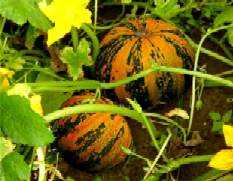 While
pumpkin seed oil is a uniquely Styrian product, I believe that the area of production always
included the southern Burgenland. I had some of my best pumpkin seed oil when we visited
relatives in the area of Güssing. In former times, the oil could be bought only in Styria and
southern Burgenland, but today it is available in supermarkets everywhere in Austria. While
pumpkin seed oil is a uniquely Styrian product, I believe that the area of production always
included the southern Burgenland. I had some of my best pumpkin seed oil when we visited
relatives in the area of Güssing. In former times, the oil could be bought only in Styria and
southern Burgenland, but today it is available in supermarkets everywhere in Austria.The oil is expensive by Austrian standards. Even in Styria itself, pumpkin seed oil is the most expensive of all salad oils. Nevertheless, the mark-up for getting it sold in the US is gigantic. To give you an example, I currently have Echtes Kürbiskernöl from the firm Peltzmann which we bought in Graz for AS109 (about $7 to 7.50) for a 500 ml (half liter) can. This compares to the $22.50 posted on the web site you gave us, for half the volume (250 ml). Perhaps you should try it! If you and your family don't like it, it would be better to have only a 250 ml bottle. (Ed note: Given that the website Margaret mentioned above is no longer active, I found another offering Styrian Kürbiskeröl for shipment to the US: http://www.kernoelman.de/_us/os_2007/en/online_shop.htm. The price thereon is €19.76 for a full liter, but when you add shipping and handling, the actual cost increases to €35.16 (about 44.75 in US$)... a better price per ml than Margaret's website but still quite costly!) NEWS FROM RIEDLINGSDORF (from Heinz Bundschuh) (ED. [Gerry] Note: Heinz continues to expand his village site. Our thanks to Heinz.) He writes: Dear friends of Riedlingsdorf, in the last week we received some historical pictures of Riedlingsdorf by Karl Hazivar, Erika Spiegel and Andrea Bruckner. You can find these pictures on our website site behind the new button 'Hist. Bilder/Pictures'. They are very interesting. http://members.aon.at/mgvriedlingsdorf/ 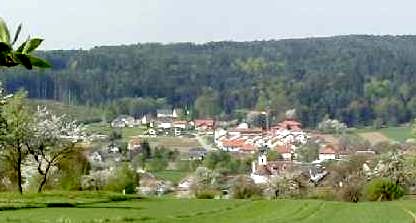 On
30th June there will be a great event in Riedlingsdorf, the 'Dorffest'. The whole village will
celebrate the inauguration of the new municipal center. On
30th June there will be a great event in Riedlingsdorf, the 'Dorffest'. The whole village will
celebrate the inauguration of the new municipal center.Two days before that, there will be a second event, the dedication of the reconstructed war memorial. I collected a lot of new information from WW-II in the last few months. I put this information into the 'Register of the dead soldiers of WW-II'. I will improve this site with the portraits. If this information is of interest to you, visit the following site (it is also part of the Riedlingsdorf-Homepage. It is hidden behind the button 'Geschichte / History' and then behind 'Overview World War II'): http://members.aon.at/dbundsch/lww2verz.htm |
||||||||||||||||||||||||||||||||||||||||||||||||||||||||||||||||||||
10) ETHNIC EVENTS LEHIGH VALLEY, PA (courtesy of Bob Strauch) Sunday, Mar 4: 35th Annual Schlachfest at the Holy Family Club in Nazareth. Music by Josef Kroboth and Johnny Dee. Info: www.holyfamilyclub.com Saturday, Mar 17, 7 - 10 pm: St. Patrick's Day Dance at the Coplay Sängerbund. Music by the Josef Kroboth Orchestra. Open to members and their guest. All guests must be accompanied by a member. Saturday, Mar 24: Bockbierfest at the Reading Liederkranz. Music by the Joe Furst Band. Info: www.readingliederkranz.com Wednesday, Mar 28: Spring German Show at the Evergreen Heimatbund in Fleetwood. Info: www.evergreenclub.org LANCASTER, PA First Tuesdays, Mar 6, 5:30-7:30 pm: All you can eat Buffet. Entertainment by Carl Heidlauf on Piano. ~ Open to the Public ~ $10 ($12 guests). Lancaster Liederkranz, 722 S. Chiques Rd, Manheim, PA. lancasterliederkranz@verizon.net, 717-898-8451. Saturday, Mar 17: Bockbier Fest. ~ Open to the Public. Lancaster Liederkranz. Musical Entertainment by Heidi und Heimat Echo. Info: www.lancasterliederkranz.com Sunday, Mar 25: Cabbage Hill Day. Lancaster Liederkranz. Music by Immergrün Musikanten. Info: www.lancasterliederkranz.com NEW BRITAIN, CT Friday, Mar 4, 7 pm: Heimat Abend. $3. Austrian Donau Club, 545 Arch Street, New Britain, CT, (860) 223-9401. Music by Joe Rogers and his band. Hot food is available from the kitchen. http://www.austriandonauclub.com/ Sunday, Mar 11, 8 am - Noon: Sonntag Frühstuck. Austrian Donau Club. Come enjoy breakfast. Friday, Mar 18, 7:30 pm: Heurigan Abend. $3. Austrian Donau Club. Music by Schachtelgebirger Musikanten. Hot food is available from the kitchen. Tuesdays at 7 pm: Men's and Women's Singing Societies meet. Austrian Donau Club. Thursdays at 7 pm: Alpenland Tänzer (Alpine Country Dancers) meet. Austrian Donau Club. ST. LOUIS, MO (courtesy of Kay Weber) Friday, March 16, 7 pm: Trivia Night. St. Louis Genealogical Society. Held at Maryland Heights Centre, 2344 McKelvey Road, West of I-270 and North of Dorsett. For additional information: StLGS :314-646-8547; E-mail: office@stlgs.org; Website: www.stlgs.org. Saturday, April 28, 8 am-4 pm: 42nd Annual Family History Conference. St. Louis Genealogical Society. Maryland Heights Centre, 2344 McKelvey Road, Maryland Heights, MO. The conference registration booklet, complete with details of the event, is at webpage: http://www.stlgs.org/images/pdf/fhc%20regis%20booklet2012.pdf. |
||||||||||||||||||||||||||||||||||||||||||||||||||||||||||||||||||||
11) BURGENLAND EMIGRANT OBITUARIES (courtesy of Bob Strauch) Rose A. Recker  Rose
A. Recker, 103, of Northampton died Tuesday January 31 in Holy Family Manor, Bethlehem. Rose
A. Recker, 103, of Northampton died Tuesday January 31 in Holy Family Manor, Bethlehem.She was the wife of the late John S. Recker. Born February 6, 1908 in Moschendorf, Austria, she was the daughter of the late John and Maria (Wolfel) Toth. Rose worked at the former Cigar Factory and the former Clyde Shirt factory for many years. She was a member of Queenship of Mary Catholic Church and the Altar and Rosary Society. Rose was a cook and a member of the former St. Joseph Sick & Beneficial Society in Northampton. Survivors: Four grandchildren; six great-grandchildren; and one great- great-grandson; a sister Gisela Urban, of Moschendorf; two nieces. Rose was predeceased by her daughters, Rose Marakovits, Mary Petrasovits and Hilda Recker. Services: A Burial Mass will be celebrated on Friday, February 3 at 10:45 a.m. in Queenship of Mary Church 1324 Newport Ave. Northampton. Family and friends may call Friday, 8:30 to 10:15 in the Reichel Funeral Home 326 E. 21st St. Northampton. Memorials may be presented to Holy Family Manor c/o funeral home. Published in Morning Call on February 1, 2012. Stefan Unger  Stefan
Unger, age 81, died February 2, 2012 at Sanctuary at the Abbey in Warren, Michigan. Stefan
Unger, age 81, died February 2, 2012 at Sanctuary at the Abbey in Warren, Michigan.Stefan was born December 9, 1930 in Moschendorf, Austria to the late Josef and Johanna (Frisch) Unger. Stefan was a retired Hi-Lo driver for Chrysler and a member of the Carpathia Club and Austrian Club. He enjoyed hunting and wine making. Stefan was the beloved husband of Katharina, who predeceased him in 2009. Loving father of Rose (Cary) Carruth, Heidi (Vinod) Unger-Joshi. Proud grandfather of Joshua and Justin Carruth and Jay Joshi. Dear brother of Joseph Unger. Visitation Sunday 2-9 p.m. and Monday 4-9 p.m. at A.H. Peters Funeral Home, 32000 Schoenherr, Warren, Mich., 48088. Funeral service will be Tuesday Noon at the funeral home. Interment will follow at Resurrection Cemetery, Clinton Township. Published in The Macomb Daily on February 5, 2012 Margaret Hanzl  Margaret
Marakovits Hanzl, 99, formerly of Clifton, NJ passed away February 6, 2012 at The House of the
Good Shepherd in Hackettstown. Margaret
Marakovits Hanzl, 99, formerly of Clifton, NJ passed away February 6, 2012 at The House of the
Good Shepherd in Hackettstown.Margaret was born on April 24, 1912 in Punitz, Austria, the youngest child of Georg and Josefa Marakovits. She lived much of her life in Clifton and was an active member of the Holy Trinity R.C. Church community in Passaic. Before her retirement, Margaret worked for many years as a mender at Forstmann Woolen Company in Passaic and Garfield. She was a member of the Burgenländer-American Society of Passaic-Clifton. Margaret is survived by a daughter, Margaret Ruppert and her husband, Frank, six grandchildren, ten great-grandchildren and two great-great-grandchildren, nieces and nephews. She was predeceased by her husband, John, who died in 1988; sons Walter F. and John; daughters-in-law Joan and Rosalie; brothers Frank and Ferdinand; sisters Johanna Dragovits, Maria Marakovits and Rosa Klucsarics. Funeral services will be Saturday 8:15 AM from the Bizub-Quinlan Funeral Home, 1313 Van Houten Avenue, Clifton and 9 AM at Holy Trinity R.C. Church, cor. Hope Avenue and Harrison Street, Passaic. Entombment to follow at Calvary Cemetery Mausoleum, Paterson. Visiting Friday from 3-7 PM only. Memorial Contributions to Holy Trinity R.C. Church, 226 Harrison Street, Passaic, NJ 07055. Published in The Record/Herald News on February 8, 2012 Joseph Zinter Jr.  Joseph
Zinter Jr. of Brewster, NY, died suddenly on Saturday, February 11, 2012 in Mt. Kisco, NY, at
the age of 72. Joseph
Zinter Jr. of Brewster, NY, died suddenly on Saturday, February 11, 2012 in Mt. Kisco, NY, at
the age of 72.Mr. Zinter was born on January 18, 1940 in Deutsch Schützen, Austria, son of the late Joseph and Hedwig (Novogratz) Zinter. He came to the United States at the age of 16 and settled in Bronx, NY. On Sept. 18, 1967, he married Carol Marzec in the Holy Family Church in Bronx, NY, and they moved to Brewster in 1973. In addition to working as a Senior Model Maker for the T.J. Watson Research Center IBM in Yorktown Heights for over 27 years, Mr. Zinter was a beloved and active member in his church, community, and in his Austrian heritage. He was a member of St. Lawrence O'Toole Church in Brewster, Knights of Columbus St. Lawrence Council 1495, an honored member of the Brotherhood of the Burgenländer, volunteered with local high school students through FIRST robotics and the Boy Scouts of America. He was raised as a farmer, enjoyed the outdoors, spending time with his grandchildren, and his annual trip to his homeland. Besides his wife Carol, he is survived by his five children: Katherine Zinter of Brewster, Rosemarie Sellati of Poughkeepsie, NY, Debra Smith of Portchester, NY, Joseph P. Zinter of Guilford, CT, John Zinter, Singapore, a sister Agnes Pohlmann of Kensington, CT, three grandchildren; Ethan Anthony and Owen Joseph Sellati and Kaitlin Mary Smith. He was predeceased by his brother Frank Zinter. A mass of Christian Burial will be celebrated Wed. Feb. 15, 2012 11 AM at St. Lawrence O'Toole Church in Brewster. Internment will follow in St. Lawrence O'Toole Cemetery in Brewster, NY. Calling hrs. will be held Tues. Feb. 14, 2012 from 2-4 and 7-9 pm at Beecher Funeral Home, 1 Putnam Ave., Brewster, NY 10509. The family has asked friends and relatives to do an act of kindness in Joe's memory. Published in The Journal News on February 13, 2012 Anna T. Mayer (née Dulmovits)  Anna
T. Mayer, 93, of Freehold Township, New Jersey, passed away on Sunday, Feb. 12, 2012, at The
Manor, Freehold. Anna
T. Mayer, 93, of Freehold Township, New Jersey, passed away on Sunday, Feb. 12, 2012, at The
Manor, Freehold.Born in Tudersdorf, Burgenland, Austria, she lived in the Bronx, NY before moving to Freehold 20 years ago. She was a salesperson for Ellen's Catering in New York City for many years before retiring. Anna was loved by and devoted to her family, especially her grandchildren. She was predeceased by her husband, Kurt, in 1986. She is survived by her son and daughter-in-law, Konrad and Ellen Mayer of Chester, NY; her daughter and son-in-law, Heidi and Victor Simon of Freehold; siblings, Alois Dulmovits and Agnes Eder, both of Austria; four grandchildren, Stephan Mayer and his wife, Jennie, Lauren Mayer and her fiancé, Richard Haskell, Kristine Lukasik and her husband, Mark, and William Simon and his wife, Lauren; and four great grandchildren, Lucas and Zoe Mayer and Katharine and Kurt Lukasik. Family and friends are invited to visit today from 2 to 4 and 6 to 8 pm, at the Freeman Funeral Home, 47 East Main Street, Freehold. A Funeral Liturgy will be celebrated at 10 am on Wednesday at St. Robert Bellarmine Church, Freehold. Interment will follow at Woodlawn Cemetery, Bronx, NY. Published in Asbury Park Press on February 14, 2012 Frank Schweitzer  Frank
Schweitzer, 82, of Bethlehem, PA, died peacefully at his residence on Friday, February 24,
2012. Frank
Schweitzer, 82, of Bethlehem, PA, died peacefully at his residence on Friday, February 24,
2012.He was born August 4, 1929 in Alsószölnök (Unterzemming), Hungary, son of the late Frank and Justina (Skerlak) Schweitzer. Frank is survived by his devoted wife of 62 years, Mary (Kerekes) Schweitzer. In 1992, Frank retired from the Bethlehem Housing Authority as a Maintenance Mechanic. He was a parishioner of St. Anne's Catholic Church, Bethlehem. Frank was also a member of the Westside Republican Club, the Windish Hall, Monocacy Field and Stream and B.V.F.H.A. Frank was an avid gardener, enjoyed landscaping and was a Philadelphia Phillies and Eagles fan. Survivors: He will be lovingly remembered by his wife, Mary; son, Louis Schweitzer and his wife, Natalie of Bethlehem; daughter, Mary Haldaman and her husband Daniel of Kunkletown; three grandchildren, Sara Stametz, Jenna and Jake Schweitzer; and a great-granddaughter, Addison. Services: A viewing will be held on Monday, February 27, 2012 from 6 to 8 p.m. at the Connell Funeral Home, 245 E. Broad St. Bethlehem, PA 18018 and again on Tuesday from 9:30 to 10 a.m. at the funeral home. A Mass of Christian Burial will be celebrated 10:30 a.m. on Tuesday at St. Anne's Catholic Church, 450 Washington Ave., Bethlehem, PA 18017. Burial will follow at Holy Saviour Cemetery. Contributions: Memorial contributions may be made to the American Diabetes Association, 2045 Westgate Dr., Bethlehem, PA 18017. Published in Morning Call on February 26, 2012. |
||||||||||||||||||||||||||||||||||||||||||||||||||||||||||||||||||||
END OF NEWSLETTER |
||||||||||||||||||||||||||||||||||||||||||||||||||||||||||||||||||||
NOTICE (Terms and Conditions): The Burgenland Bunch (BB) was formed and exists to assist Burgenland descendants in their research into their heritage and, toward that end, reserves the right to use any communication you have with us (email, letter, phone conversation, etc.) as part of our information exchange and educational research efforts. • If you do not want your communication to be used for this purpose, indicate that it is "confidential" and we will abide by that request. • Correspondents who communicate with the BB without requesting confidentiality retain their copyright but give a non-exclusive license to the BB allowing us to forward to BB members, publish in our monthly newsletter or on our website, and/or subsequently and permanently archive all or parts of such communications. The Burgenland Bunch homepage (website) can be found at: http://www.the-burgenland-bunch.org/ Burgenland Bunch Newsletter, copyright © 2012 by The Burgenland Bunch All rights reserved. Permission to copy excerpts granted if credit is provided. |
 News
News What
baffles me, is how (or why) did my email address end up on the mailing list for this
conference? After all, what I know of biomass is not enough to fill a toilet. Perhaps it was
my writings in the BB Newsletters about the Zeil-1 EU funds... but, if so, they must
have magically anticipated what appears later in this newsletter, as I do write about a
biomass project near Güssing that was funded by ERDF monies. Another possibility is they quite
recently scanned the web looking for names in the "global biomass community" and discovered
the draft of that article, which I had uploaded to check its formatting a week or so before
their email arrived. Either way, it continues to amaze me that my email address has become so
widely distributed! On the off-chance that any of you readers have an interest, I'll share
their website address,
What
baffles me, is how (or why) did my email address end up on the mailing list for this
conference? After all, what I know of biomass is not enough to fill a toilet. Perhaps it was
my writings in the BB Newsletters about the Zeil-1 EU funds... but, if so, they must
have magically anticipated what appears later in this newsletter, as I do write about a
biomass project near Güssing that was funded by ERDF monies. Another possibility is they quite
recently scanned the web looking for names in the "global biomass community" and discovered
the draft of that article, which I had uploaded to check its formatting a week or so before
their email arrived. Either way, it continues to amaze me that my email address has become so
widely distributed! On the off-chance that any of you readers have an interest, I'll share
their website address,  cousin,
Imre Hurtik, of Györ, Hungary (he was born in Rajka, Hungary, which is right where Slovakia,
Burgenland and Hungary come together). One of the bits of news that Imre mentioned was that he
was a member of the Rotary Club in Györ, being one of the coordinators of their Rotary
International Student Exchange Program. This year they have two American girls and one
Brazilian boy in Györ. Next year they will bring in five exchange students who will stay with
them for 10 months. Correspondingly, they sent an equal number of students to other countries.
cousin,
Imre Hurtik, of Györ, Hungary (he was born in Rajka, Hungary, which is right where Slovakia,
Burgenland and Hungary come together). One of the bits of news that Imre mentioned was that he
was a member of the Rotary Club in Györ, being one of the coordinators of their Rotary
International Student Exchange Program. This year they have two American girls and one
Brazilian boy in Györ. Next year they will bring in five exchange students who will stay with
them for 10 months. Correspondingly, they sent an equal number of students to other countries. Cartoon
of the month: I knew there had to be an explanation!
Cartoon
of the month: I knew there had to be an explanation! Now
at full capacity, when all the gas is burned for electricity, the plant produces 14,000
megawatt-hours of power a year. The cost is around 0.15€ per kWh, which is much less than the
price, ~0.25€, being paid for other sources of electricity in the area. It is estimated that
this pilot plant, together with another wood-fired heating system with a capacity of 42 MW,
means that €18 million stays in the Güssing district each year that otherwise would have gone
elsewhere. In total, it represents a massive return on investment and makes Güssing more
self-sufficient for electricity and heat.
Now
at full capacity, when all the gas is burned for electricity, the plant produces 14,000
megawatt-hours of power a year. The cost is around 0.15€ per kWh, which is much less than the
price, ~0.25€, being paid for other sources of electricity in the area. It is estimated that
this pilot plant, together with another wood-fired heating system with a capacity of 42 MW,
means that €18 million stays in the Güssing district each year that otherwise would have gone
elsewhere. In total, it represents a massive return on investment and makes Güssing more
self-sufficient for electricity and heat.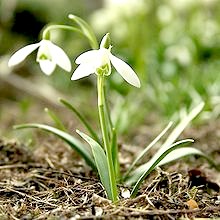 Galantamine
was originally extracted from the bulbs and flowers of Galanthus Caucasicus, more
commonly known as the spring flower Snowdrop, as well as related flowers. In the 1950s,
one kilogram of galantamine cost up to $30,000 to produce given that a ton of Snowdrops
yielded just 8 grams of galantamine. The research into the industrial chemical synthesis
of galantamine carried out by SanoChemia Pharmazeutika AG made it possible to produce the
substance in volume at a much more reasonable cost, leading to worldwide patents in 1996 and
2000.
Galantamine
was originally extracted from the bulbs and flowers of Galanthus Caucasicus, more
commonly known as the spring flower Snowdrop, as well as related flowers. In the 1950s,
one kilogram of galantamine cost up to $30,000 to produce given that a ton of Snowdrops
yielded just 8 grams of galantamine. The research into the industrial chemical synthesis
of galantamine carried out by SanoChemia Pharmazeutika AG made it possible to produce the
substance in volume at a much more reasonable cost, leading to worldwide patents in 1996 and
2000. While
Snowdrop flowers are likely to be the last thing visitors to Sanochemia will spot, the site in
Neufeld an der Leitha accommodates the entire gamut of research, production, technology and
logistics required for the industrial production of galantamine. The site produces a white
power, which is then processed into pills and sold worldwide under the name Reminyl by
Johnson & Johnson and Shire Pharmaceuticals.
While
Snowdrop flowers are likely to be the last thing visitors to Sanochemia will spot, the site in
Neufeld an der Leitha accommodates the entire gamut of research, production, technology and
logistics required for the industrial production of galantamine. The site produces a white
power, which is then processed into pills and sold worldwide under the name Reminyl by
Johnson & Johnson and Shire Pharmaceuticals.